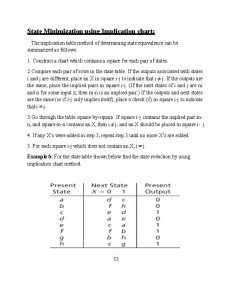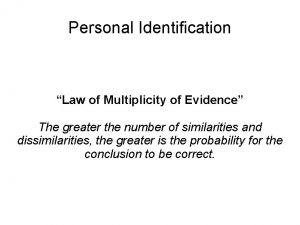TwoSided Markets Implications for Competition Analysis Anne Perrot














- Slides: 14

Two-Sided Markets: Implications for Competition Analysis Anne Perrot 08 February 2013 1

Introduction Topical subject One of the most recent advances in industrial organization ‒ Seminal papers by Caillaud and Jullien (2003), Rochet and Tirole (2004) In connection with the digital economy and the emergence of “platforms” Allows to better understand the business models of these platforms and the competitive problems associated with them Many examples: Media (newspapers, TV…) Credit cards Stock exchange and market places Real estate agencies Singles clubs And of course search engines Specific issues for competition analysis Relation between prices/costs and pricing problems Trends towards integration and building-up of big firms 2

Overview of the presentation Examples of two-sided markets Pricing issues Competitive issues on two-sided markets Single homing vs. Multi-homing Costs and benefits of competition on two-sided markets 3

A classical example : the singles clubs Network externalities The value of the service depends on the number of users The club must have women to attract men… …And men to attract women Each side of the platform exerts a positive externality over the other one. But the presence of network effects is not enough to define a twosided market Example: telephone, softwares… Network effect associated with the number of users : the larger the installed base of users, the higher the utility derived from the use of the telephone, the softwares… This is a « direct » network effect. The externality derived from the two-sided dimension is an « indirect network effect » : one side of the market exerts an externality over the other one. 4

Consequences of the « two-sided » dimension Coordination problem Both sides have to be present on the platform to make it work Therefore, in order to trigger the network effect off, it may be necessary to subsidize one side in order to attract the other one. In a e-commerce platform, subsidize labels to attract buyers, In the singles club example : subsidize women in order to attract men This does not mean that women are less costly for the club, but rather that they generate externalities over the other side (men) that benefit the activity of the platform. This subsidization mechanism induces a disconnection between costs and prices, regardless of any competitive mechanism. The side whose demand is more elastic and that generates externalities over the other side has to be subsidized. 5

Many examples of that type of indirect network effects Credit cards: Two sides = merchants and customers, Platform = payment system (2 banks) => « four-sided market » Real estate agencies: Two sides = buyers and sellers, platform = website, physical agency Operating systems: Two sides = users and developpers, platform = operating system Stock exchange: Two sides = portfolio managers and issuing agents Media: Two sides = readers and advertisers, platform = newspaper, search engine, TV channel And of course search engines Three sides at least : internet users, content providers and advertisers. 6

Consequences for the pricing Prices charged to both sides may differ One side may face a zero price Or even may be payed in order to participate in the market This enhances the value of the platform During the introductory period of the good, prices may be very low in order to attract users and make the platform attractive in the future. A platform with an installed base may hold a competitive advantage First mover advantage Magnitude of the advantage depends on the ability to belong to many platforms (multi-homing or single-homing) This may intensify competition in the initial period to attract the installed base. 7

Search engines : pricing issues A search engine is a multi-sided platform Internet users, content providers, advertisers Price structure : For Internet users, free access. Content providers can put their content at the disposal of users at zero price Advertisers pay for the whole system. Internet users are attracted by contents But content providers receive traffic through the search engine On Google, prices charged to advertisers result from an auction mechanism In principle, this leads to competitive prices But Google is able to determine the supply of advertising space: has an impact on prices. Some content providers (newspapers’ websites) want to receive a payment, due to their positive externality on users 8

Consequences for the pricing In a two-sided market, the value generated by the platform depends On the total price payed by both sides (P = p 1+p 2) But also on the price structure (p 1, p 2), that is, on the split of P between both sides Examples: fixed fee or use-based unit prices; free subscription … Allows to separate two-sided markets and other types of markets Retail (simple vertical interaction) Labor market (relationships between employers and employees in the firm) … In these « simple » markets The price structure does not matter Negociation and transactions occur between the two sides directly 9

Competitive issues Many competing platforms: This situation raises different issues according to the fact that « multihoming » or « single-homing » prevails. Mixed situations (multi-homing on one side, single-homing on the other) are also possible, for example if exclusivity contracts on one side Advantages of competition vs. monopoly: depend on many features. In the case of single-homing on both sides : Each platform offers a restricted access to the other side Ex: in an airport, each traveller has only access to the shops of his terminal, and conversely Competition may be an unstable situation Competition or switch to monopoly, depending on ‒ initial conditions, ‒ relative strength of differentiation versus network effects. 10

Competitive issues : multi-homing on both sides This makes both platforms (at least partially) substitutes But multi-homing may be unstable If platforms are close substitutes And if there are fixed subscription costs In this case: Switch to monopoly is possible Some exclusivity contracts may be pro-competitive (to favour differentiation and to preserve mutiplicity of platforms) on one side But not « too much » exclusivity If there is multi-homing on one side (1), and single-homing on the other (2), then the platform may obtain high profits from side 1 agents who want to have access to side 2 agents Then competition erodes the profits and benefits the agents belonging to the multi-homing side 1. 11

Search engines : structural issues Advantage of first entrant Helps to build an installed base, triggers the network effect. Advantage of large size of the engine : multiplicity of contents attracts users, who attract advertising revenues. Multi-homing on the side of users and of contents providers, but many exclusivity contrats on the advertisers’ side (who cannot publish the same ad on two different engines) Exclusivity + dominance may prevent other engines from developping their activity But on the other hand : spontaneous (structural) trends towards dominance And exclusivity may preserve differentiation between platforms and prevent the market from switching to monopoly. Ambiguous effects of exclusivity on the competitive structure. 12

Conclusion Pricing: usual analysis can be irrelevant predation, prices driven by costs… Number of platforms With single homing, the multiplicity of platforms lowers the quality of service (a user on the single homing side 1 cannot interact with all the potential members of side 2) But this also acts as a discipline device on the behavior of platforms and deters from pricing to high. Switch to monopoly possible With multi-homing, many platforms enhance the quality of service (all members of one side can interact with all members of the other) But can be an unstable situation and lead to monopoly Exclusivity Balance between competition « for » the market and « on » the market Some exclusivity can be pro-competitive, too many exclusivity contracts are not. 13

t Blablabla Blabla 2, Square de l’Opéra-Louis-Jouvet F - 75009 Paris 37, Square de Meeûs B-1000 Brussels contact@mapp-economics. com 14
 Anne perrot
Anne perrot Anne laure perrot
Anne laure perrot Lionel perrot
Lionel perrot Thomas abbas
Thomas abbas Norbert perrot
Norbert perrot Dr marc de perrot
Dr marc de perrot Lump sum subsidy
Lump sum subsidy Perfect competition vs monopolistic competition
Perfect competition vs monopolistic competition Market structures venn diagram
Market structures venn diagram Competition refers to
Competition refers to Database approach
Database approach Constructive tools examples
Constructive tools examples State reduction using implication table
State reduction using implication table Nursing implications for synthroid
Nursing implications for synthroid Law of multiplicity of evidence definition
Law of multiplicity of evidence definition


























